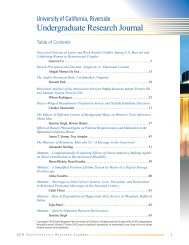2010 - Undergraduate Research, Scholarship and Creative Activity
2010 - Undergraduate Research, Scholarship and Creative Activity
2010 - Undergraduate Research, Scholarship and Creative Activity
Create successful ePaper yourself
Turn your PDF publications into a flip-book with our unique Google optimized e-Paper software.
completely mineralize a wide variety of<br />
compounds. TiO 2 can also be used in many<br />
different applications such as photovoltaics <strong>and</strong><br />
photocatalysts, as well as applications in<br />
cosmetics, sunscreens, <strong>and</strong> paints. Many of the<br />
synthesis methods used to TiO 2 require high<br />
temperatures or extreme pH‘s to achieve the<br />
desired phase, shape, <strong>and</strong> size of the material.<br />
However mineralizing biological systems<br />
demonstrate how nature can produce elegant<br />
structures at room temperature through<br />
controlled organic-mineral interactions. These<br />
organics exist as either soluble forms or as<br />
insoluble scaffolds that are often used to control<br />
size, shape, <strong>and</strong> orientation of mineral. We are<br />
using biologically-inspired scaffolds to template<br />
the nucleation <strong>and</strong> growth of inorganic materials<br />
such as TiO 2 . These lig<strong>and</strong>s (modeled after<br />
specific mineral functionalities identified in<br />
biomineral systems) interact with minerals<br />
during nucleation <strong>and</strong> growth can be help to<br />
control the size, shape, <strong>and</strong> phase of these<br />
particles <strong>and</strong> ultimately, their properties.<br />
Underst<strong>and</strong>ing the fundamental nucleation <strong>and</strong><br />
growth mechanism is critical to control the<br />
microstructure <strong>and</strong> therefore function.<br />
Nanosized rutile <strong>and</strong> anatase particles were<br />
synthesized using a biologically inspired method<br />
at relatively low temperatures <strong>and</strong> mild pH<br />
conditions. The effects of reaction conditions on<br />
phase <strong>and</strong> grain size were investigated <strong>and</strong><br />
discussed from coordination chemistry <strong>and</strong><br />
coarsening mechanisms. We demonstrate the<br />
control over the size <strong>and</strong> phase of the TiO 2<br />
nanostructures which resulted in enhanced<br />
photocatalytic degradation of an organic dye.<br />
Within Her Strength: A Framework for<br />
Addressing Sexual Violence in Our<br />
Community<br />
Jessica Yamane, Political Science/ Women‘s<br />
Studies Concentration<br />
Mentors: Andrea Smith, Setsu Shigematsu<br />
Department of Media <strong>and</strong> Cultural Studies<br />
Christine Gailey, Department of Women‘s<br />
Studies <strong>and</strong> Anthropology<br />
Sexual terrorism is used as a mechanism by<br />
which men dictate women‘s behavior <strong>and</strong><br />
actions through actual or implied violence.<br />
Scholars note that the persistent characterization<br />
of women (particularly poor women of color) as<br />
―deviant‖ preserves a ―rape culture‖ that<br />
condones sexual terrorism as a method of social<br />
control. Many anti-violence programs in the<br />
United States have been established to address<br />
the perpetration of interpersonal acts of violence<br />
such as domestic violence or sexual abuse. Yet<br />
the amount of violence against women has<br />
continued to rise in recent decades. I argue that<br />
the ineffectiveness of these anti-violence<br />
programs is due to their lack of engagement with<br />
the mechanisms by which violence operates<br />
structurally. Thus, my presentation outlines the<br />
development <strong>and</strong> activities of Within Her<br />
Strength (WHS), an organization that I designed<br />
in response to my critique of anti-violence<br />
movements. WHS is a self-defense program that<br />
utilizes American Kenpo Karate in program<br />
curriculum. Yet we concurrently delve further<br />
into systemic issues of violence by incorporating<br />
relational boundary setting exercises <strong>and</strong><br />
engaging in discussions about the political<br />
systems that maintain violence within our<br />
communities. Working in partnership with<br />
women in the Riverside community who are<br />
experiencing violence first h<strong>and</strong>, we draw on<br />
feminist epistemologies, dialogical pedagogy,<br />
<strong>and</strong> restorative justice models to generate<br />
solutions resonant to the problems identified by<br />
the women directly affected. We aim to activate<br />
individual citizen‘s sense of responsibility for<br />
their community‘s wellbeing <strong>and</strong> to support their<br />
efforts to eradicate systemic cycles of violence<br />
via collective organizing techniques.<br />
Adultery in Athens during the 5 th <strong>and</strong> 4 th<br />
Centuries BC<br />
Teresa Yates, Classical Studies<br />
Mentors: Thomas Scanlon, Wendy Raschke<br />
Department of Comparative Literature <strong>and</strong><br />
Foreign Languages<br />
Adultery has been a problem since the beginning<br />
of relationships. In ancient Athens, it was seen<br />
as harmful not only to the person suffering from<br />
having an adulterous partner, but also to society.<br />
Since the only extant sources regarding adultery<br />
are literature, historians must accept that some<br />
sources present adulterous circumstances in an<br />
Fourth Annual UCR Symposium for <strong>Undergraduate</strong> <strong>Research</strong>, <strong>Scholarship</strong> <strong>and</strong> <strong>Creative</strong> <strong>Activity</strong><br />
50














